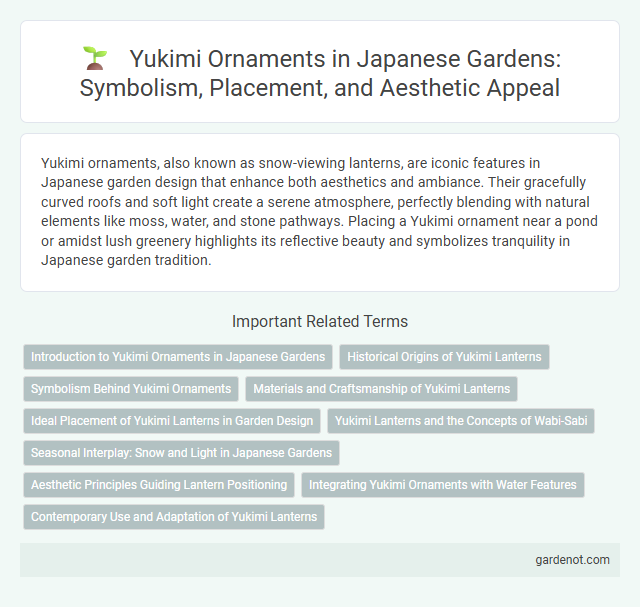Yukimi ornaments, also known as snow-viewing lanterns, are iconic features in Japanese garden design that enhance both aesthetics and ambiance. Their gracefully curved roofs and soft light create a serene atmosphere, perfectly blending with natural elements like moss, water, and stone pathways. Placing a Yukimi ornament near a pond or amidst lush greenery highlights its reflective beauty and symbolizes tranquility in Japanese garden tradition.
Introduction to Yukimi Ornaments in Japanese Gardens
Yukimi ornaments, known as "snow-viewing" lanterns, are traditional Japanese garden elements designed to enhance winter landscapes by reflecting snow's beauty. Typically crafted from stone, these lanterns feature broad, overhanging roofs that catch and showcase snow, creating a serene and poetic atmosphere. Their placement near water or moss-covered grounds emphasizes harmony with nature, embodying the aesthetic principles of Japanese garden design.
Historical Origins of Yukimi Lanterns
Yukimi lanterns, also known as "snow-viewing lanterns," originated in 17th-century Japan during the Edo period, reflecting the aesthetic principles of Japanese garden design. These stone lanterns were specifically crafted with wide, overhanging roofs to catch and highlight the snow, symbolizing seasonal beauty and serenity. Their historical significance lies in harmonizing natural elements with architectural features, embodying the Japanese cultural appreciation for fleeting moments in nature.
Symbolism Behind Yukimi Ornaments
Yukimi ornaments, often known as snow-viewing lanterns, symbolize tranquility and the harmonious relationship between nature and human presence in Japanese gardens. Their wide, sloping roofs collect snow, representing the beauty of seasonal change and the impermanence of life. These lanterns evoke a meditative atmosphere, encouraging reflection and appreciation of the natural world.
Materials and Craftsmanship of Yukimi Lanterns
Yukimi lanterns are traditionally crafted from high-quality granite or bronze, chosen for their durability and natural aesthetic harmony with garden landscapes. The stone or metal is meticulously carved by skilled artisans, ensuring precise detailing that highlights both function and beauty in low ambient light. This craftsmanship balances weight and stability, essential for the lantern's signature wide roof that mimics falling snow, enhancing the serene atmosphere of Japanese gardens.
Ideal Placement of Yukimi Lanterns in Garden Design
Yukimi lanterns are ideally placed near water features or low shrubbery to enhance their soft, ambient glow, complementing the serene atmosphere of a Japanese garden. Positioning these lanterns slightly elevated or near stepping stones allows light to reflect beautifully on the water's surface, creating a harmonious balance between illumination and natural elements. Careful placement ensures the lanterns highlight key focal points without overpowering the garden's subtle, tranquil aesthetic.
Yukimi Lanterns and the Concepts of Wabi-Sabi
Yukimi lanterns, also known as "snow-viewing" lanterns, embody the Japanese aesthetic of wabi-sabi by showcasing simplicity and natural beauty through their weathered stone surfaces and rustic, asymmetrical designs. These lanterns are traditionally placed near water in Japanese gardens to create serene reflections, emphasizing impermanence and the passage of time. Their subtle elegance and integration with natural surroundings highlight the wabi-sabi principles of transience, imperfection, and quiet tranquility.
Seasonal Interplay: Snow and Light in Japanese Gardens
The Yukimi ornament, also known as the "snow-viewing lantern," enhances the seasonal interplay of snow and light in Japanese gardens by its wide, flat roof that catches delicate snow accumulation, creating a luminous contrast against the dark stone. This design element not only highlights the tranquil beauty of winter landscapes but also reflects traditional Japanese aesthetics emphasizing harmony between nature and human artifice. Its strategic placement near water features or pathways maximizes light reflections, enriching the garden's serene atmosphere throughout the snowy season.
Aesthetic Principles Guiding Lantern Positioning
Yukimi lanterns in Japanese gardens embody wabi-sabi aesthetics, emphasizing simplicity and natural beauty. Their positioning follows the principle of shakkei, or "borrowed scenery," strategically placed near water to reflect light and integrate with the landscape. Optimal placement balances asymmetry and harmony, creating a tranquil, contemplative atmosphere that enhances seasonal changes and garden depth.
Integrating Yukimi Ornaments with Water Features
Yukimi ornaments enhance Japanese garden aesthetics by complementing water features like ponds or streams with their broad, snow-viewing roofs that subtly reflect in the water's surface. These stone lanterns create serene focal points, harmonizing natural elements and inviting calm contemplation through their strategic placement near water. Integrating Yukimi ornaments with water features elevates the garden's tranquil ambiance and emphasizes the seamless connection between stone, water, and seasonal beauty.
Contemporary Use and Adaptation of Yukimi Lanterns
Contemporary use of Yukimi lanterns in Japanese gardens often incorporates modern materials such as stainless steel and weather-resistant composites to enhance durability while preserving traditional aesthetics. Adaptations include integrating LED lighting technology to provide energy-efficient illumination that highlights garden features during nighttime. Designers also experiment with minimalist and abstract forms, blending the classic Yukimi shape with contemporary landscape architecture for a harmonious balance of tradition and innovation.
Yukimi ornament Infographic

 gardenot.com
gardenot.com